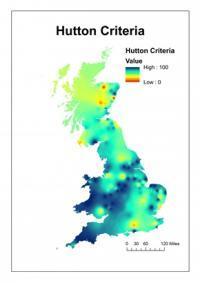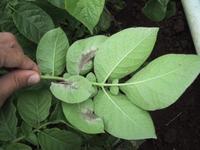United Kingdom
December 9, 2016
 Researchers from ENDURE’s Scottish partner, the James Hutton Institute (JHI), have unveiled new criteria for measuring the risk of late blight in potato crops, which will help to improve the UK’s alert system from 2017.
Researchers from ENDURE’s Scottish partner, the James Hutton Institute (JHI), have unveiled new criteria for measuring the risk of late blight in potato crops, which will help to improve the UK’s alert system from 2017.
Researchers revealed the new risk criteria, named after the institute, at the AHDB’s Agronomists’ Conference in December. AHDB, a statutory levy board funded by farmers, growers and others in the supply chain, sought the institute’s assistance to produce an improvement of the 60-year old Smith Period, the current method for predicting blight pressure. In recent years, agronomist John Sarup told the JHI website, blight had been found on plants before the arrival of any conventional Smith Periods.
The website reports that PhD student Siobhán Roísín Dancey, working in collaboration with supervisors Peter Skelsey (information and computational sciences) and David Cooke (cell and molecular sciences), examined relationships between reported outbreaks and recorded Smith Periods, and performed controlled environment experiments to determine new thresholds indicative of high blight risk.
“Previously the collective reasoning was that a lowering of the temperature threshold would provide an earlier indication of blight pressure, and certainly some systems out there adjusted their operating criteria in line with this in efforts to improve the services available to growers,” Siobhán told the website.
“While our data did demonstrate some improvement with this approach, it was not a pronounced effect, and in fact, a reduction in the period of relative humidity at 90 percent or above down to six hours from the present eleven proved the most striking match for those conditions which resulted in an actual blight outbreak.”
The findings were tested against more than 2,000 historic reports of potato late blight outbreaks, with the Hutton Criteria demonstrating a significant overall improvement in performance compared to the Smith Period.

Claire Hodge, AHDB Potatoes Knowledge Exchange Manager, told the website: “The Smith Period has been immensely valuable in assessing blight risk to date. Originally developed by L.P. Smith in 1956, it was an improvement on the previously used system – the Beaumont Criteria.
“But we need to continue to optimise in response to changes in climate and developments in technology and the Hutton Criteria provide that timely enhancement. Late blight [pictured right], caused by the pathogen Phytophthora infestans , remains the single most important disease for the British potato trade. Spreading quickly in the foliage, a typical blight pressure season can be costly to the industry.”
John Sarup, agronomist and specialist potato adviser for SPUD Agronomy, told the website: “It’s a concern for potato growers every single year and a tool for identifying high-risk periods of disease development is crucial to help us protect our crops and give us the confidence to schedule control activities at the right time, to the right level. However in recent seasons, blight has been found on crops even before any conventional Smith Periods had been recorded, meaning the current tools and systems just weren’t reliable enough to support precision decision-making.”
AHDB’s Fight Against Blight (FAB) campaign includes a free alert service for levy payers and aims to take practical advantage of the research in 2017.
For more information: